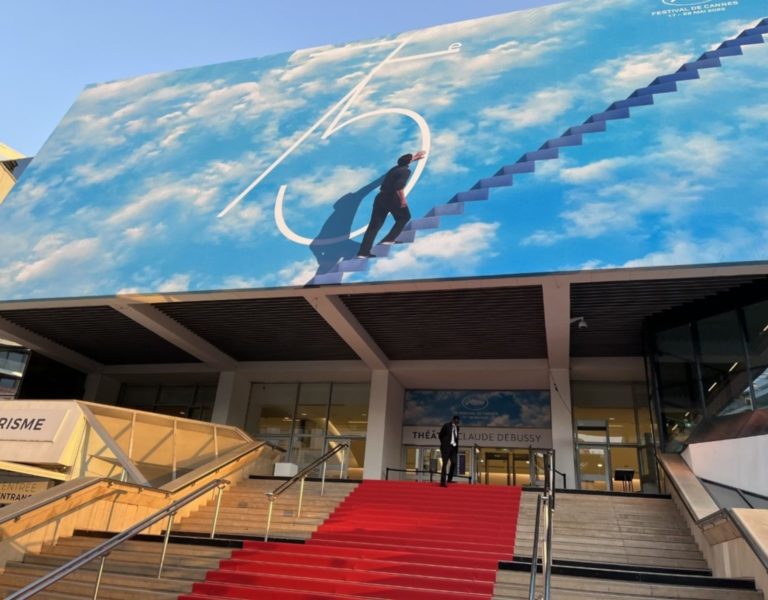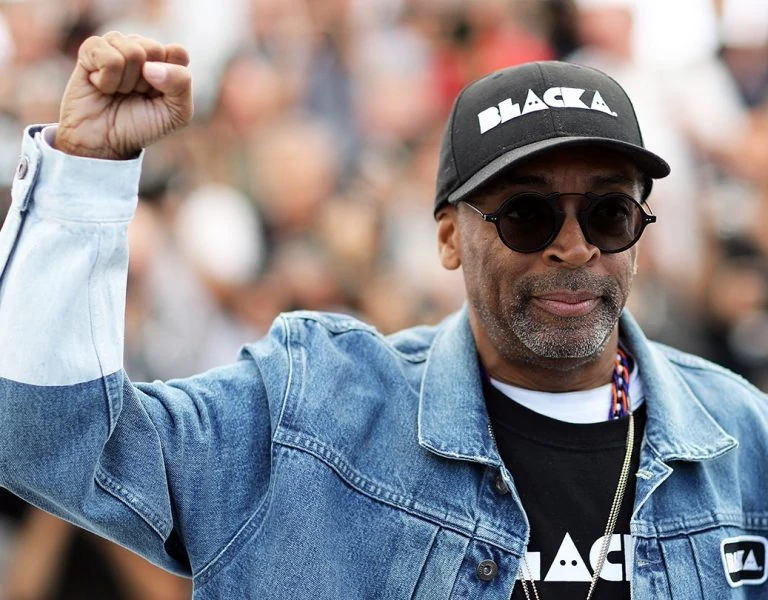Moteurs… action!
Despite the shadow of the war in Ukraine, the Cannes Film Festival managed to celebrate the beauty of cinema and its stars.
The 75th Cannes Film Festival was not just about glamour because a European war is raging on and off screen. At the opening gala, Ukrainian President Volodymyr Zelensky addressed the festival via live video link and said that cinema should not remain silent about the Russian attack on Ukraine. He called on filmmakers to take action. “The most brutal dictators of the twentieth century loved cinema,” said the former actor, who stressed the need for a new Charlie Chaplin to satirise contemporary dictators as he did in The Great Dictator.
Since the letter ‘Z’ has become a symbol of the Russian invasion of Ukraine, the French director Michel Hazanavicius changed the title of his festival-opening film. His zombie-horror comedy, a remake of the Japanese film hit One Cut of the Dead, was originally called Z (Comme Z) but was renamed Coupez! The story involves a film crew that is supposed to shoot a zombie movie but is instead attacked by real zombies. The film begins with a 30-minute-long take, hand-held from the shoulder, that cinematographer Jonathan Ricquebourg rehearsed with the actors over the course of an entire month to work out the complex choreography.
Cruise celebrated
“There’s a very specific way to make movies for cinema, and I make movies for the big screen”, said Hollywood star Tom Cruise, who produced and starred in Top Gun: Maverick, a sequel to his hit film. “I’ve loved aviation my whole life long and I wanted to be able to shoot film in an F-14. We had to adapt cameras for shooting in F-18s. I also had to create a whole training program for the actors to understand how to act like pilots, but I also had to teach them about editing and lighting, and the fighter pilots had to teach them about filming.” The idea was to use the camera from the point of view of the fighter pilots for the audience to identify with them. The shots set up inside the jet fighters were taken by four Sony Venice cameras. The actors had to take G-force training sessions to withstand the physical demands of the gravitational pressures during flights, and they had to get training in cinematography so that they could operate the cameras inside the cockpit.
Before the screening, Cruise was awarded an honorary Palme d’Or, for which he received a five-minute standing ovation, and the French Air Force put on a special air show for the occasion. Eight fighter jets flying in formation streaked the sky above the red carpet with red, white, and blue plumes of smoke. This powerful jet performance was rather horrifying for Ukrainian filmmaker Hanna Bilobrova, who presented the documentary Mariupolis 2 in Cannes. The footage of the film about the devastated city was shot by her partner, Lithuanian director Mantas Kvedaravičius, who was killed in the Ukraine in April 2022.
The French Air Force flight demonstration was out of sync with the festival’s approach to create a new image of sustainability. The electric limousines that were chauffeuring stars to the red carpet also diminished the impact of the green event. Even so, the red carpet hasn’t lost any of its attraction.

Awards and achievements
The dark side of the world of beauty is the theme of new Swedish movie Triangle of Sadness, which won director Ruben Östlund his second Palme d’Or (following 2017’s The Square). This social satire features two models on a cruise ship. During the cruise, they cope with outrageous passengers, such an old British couple who sell landmines, and the ship’s captain who, during a storm, gets drunk and starts reading aloud from The Communist Manifesto.
To simulate heavy seas on the yacht, set designer Josefin Åsberg built the whole interior of the yacht dining room on a gimbal which could be tilted about 20 degrees in any direction. In the dining scene, the guests start vomiting. When the ship of fools finally runs aground, the passengers end up being stranded on a desert island. The stereotypical power relationships are reversed: Only the cleaning crew knows how to catch a fish and start a fire. The film was shot over 73 days in Sweden and Greece. “I chose to shoot Triangle of Sadness with the Alexa LF because I know how much Ruben manipulates the images afterwards”, said cinematographer Fredrik Wenzel. “There are close to zero images in the final film that haven’t been manipulated in some way. Ruben stitches different takes together. Or he adds a detail, like a piece of fabric hanging over a chair. Or he extends the image and makes it wider. The list is endless.”
The script award went to Tarik Saleh’s gripping thriller Boy from Heaven. A fisherman’s son begins his studies at the University of Cairo, but he gets entangled in of a labyrinth of intrigue and conflicting allegiances. A similar fate awaits the protagonist of Claire Denis’ romantic thriller Stars at Noon, set in 1984 during the Nicaragua guerrilla war. A playful romance between an American businessman and a young woman turns into a dangerous cat-and-mouse game. French cinematographer Éric Gautier AFC shot the Grand Prix-winning film on an Alexa Mini. The award went ex-aequo to Lukas Dhont’s coming-of-age drama Close, which examines the friendship of two boys which suddenly ruptures. Belgian cinematographer Frank van den Eeden NSC SBS also created the film’s cosy imagery with an Alexa Mini. The Italian competition film Nostalgia by Mario Martone also explores a decisive experience that separates two young friends. A grown-up businessman returns to Naples, where he once sped through its narrow streets on a motorcycle, to settle a score with an old friend.

In Armageddon Time, American director James Gray looks back on his old neighbourhood in Queens in the 1980s. His semi-autobiographical movie tells the story of the eleven-year-old son of Ukrainian Jewish immigrants who quickly runs up against a wall in the land of opportunity. Armageddon Time is the first film by James Gray that was shot digitally. Cinematographer Darius Khondji ASC AFC, known for his work with Wong Kar-wai on My Blueberry Nights, Bernardo Bertolucci on Stealing Beauty, Michael Haneke on Amour, and David Fincher on Se7en, received the Angénieux ExcelLens Award in Cinematography at Cannes. Since he shot the film on an Alexa 65, he did a film-out in post-production in order to give the footage a film look. “The film-out for digital means transferring the digital to film, then doing an internegative, and getting the grain on the internegative – or even going further. So, you use the organic grain structure to put it together.” For Khondji, film remains his first choice: “It’s just so sexy to shoot on film, the texture is beautiful; it looks great on skin tones.”
Khondji has been using Angénieux zoom lenses since the very beginning of his career. “It was probably the first zoom lens I saw as a student. I loved anamorphic lenses, but we couldn’t afford them at that time. Now I use Angénieux zooms all the time whenever I shoot commercials or music videos. I love operating; it is a very physical thing.”
Angénieux recognises the work of promising young cinematographers. The Angénieux Special Encouragement award was given to Dutch cinematographer Evelin van Rei. The prize gives her an opportunity to use Angénieux’s cutting-edge lens technology for her next film. “For me, emotion, narrative, and story are of the utmost importance”, van Rei points out. “And images enhance these elements. They tell a story a certain way.”

Film at the fore
At this year’s festival, 26 productions were shot on Kodak film. The historical drama Corsage by Austrian director Marie Kreutzer puts an end to the myth of the Empress Elisabeth of Austria, known as Sissi. German cinematographer Judith Kaufmann shot the film on an Arricam LT in 3-Perf. “Marie told me we should shoot the scenes as if we were in the empress’ living room.”
“Film is a medium that works for you as a cinematographer”, added French cinematographer Balthazar Lab. “It gives the picture you are making a specific and beautiful quality. Of course, you can achieve this digitally, but it requires a lot of more work, especially in post-production, to find the specific colour tweak, the grain, and all the characteristics of film that are so natural and pleasant. When you shoot on film directly, you don’t have to work for it.”
French cinematographer Paul Guilhaume AFC filmed Léa Mysius’ Director’s Fortnight film The Five Devils with an Arricam LT on 35mm. “2-perf provided us flexibility, long takes, and a pretty gritty image”, said Guilhaume. “The combination of film and spherical lenses with this wide aperture allows you limit the additional lighting you need to add.”

Meanwhile, American documentary filmmaker Brett Morgen hit the jackpot when he was granted access to never-before-seen drawings, recordings, and films by David Bowie. This provided a fascinating insight into the British pop icon’s work for Moonage Daydream, mixed by the Oscar-winning sound team of Bohemian Rhapsody. Baz Luhrmann received kudos for his biopic Elvis about the King of Rock ‘n’ Roll, with newcomer Austin Butler in the lead role.
While many filmmakers retold stories from the past, the Canadian director David Cronenberg glimpsed into the future. His dark film Crimes of the Future is about human mutations who can digest plastic and create new organs. This phenomenon is presented in live-performance acts by an artist couple who operate with remote-controlled scalpels. “Surgery is the new sex,” whispers a young woman in the ear of old men. Decadence knows no limits.










